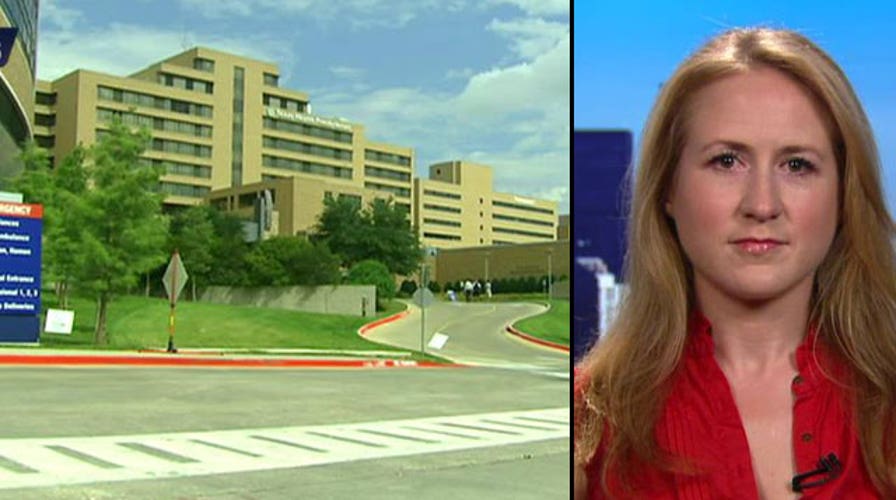Patient: Texas Health Presbyterian Hospital wasn't prepared
Reporter gives firsthand account of Ebola confusion
WASHINGTON – While federal and local officials rethink their Ebola containment strategy, they've also riled front-line health care workers by repeatedly pointing the finger at nurses as new infections surface.
Most recently, federal sources even suggested the second Dallas nurse to test positive for the virus "lied" to the CDC about her symptoms.
Nursing associations, though, are pointing the finger right back, saying the system is not doing enough to protect them.
“It’s critical that we do not blame individuals. We need to support our health care workers so they feel safe and empowered," Adam Wasch, a spokesman for the Texas Nurses Association, told FoxNews.com.
From the outset in Texas, hospital staff were faulted for releasing Liberian national Thomas Eric Duncan, who died last week of the virus. Indeed, the hospital later said it made a mistake discharging Duncan after he first came to the facility on Sept. 25. Saying he was feeling ill and had recently returned from Liberia – one of the countries hardest-hit by Ebola – Duncan was allowed to leave the hospital. He died on Oct. 8.
Since Duncan’s death, though, two nurses who cared for him have tested positive for Ebola -- and federal officials have seemed to initially fault them.
Blaming health care workers didn’t sit well with National Nurses United, the nation’s largest union of registered nurses.
“This month has been a nightmare frankly for the nurses,” executive director Roseann Demoro told reporters on Wednesday, later adding, “This is the responsibility of our elected officials to actually protect this nation. And we are asking the president of the United States to invoke his executive authority to protect the nurses.”
The two nurses contracted the virus despite wearing protective uniforms meant to keep them safe. More than 70 others who had been in contact with Duncan are currently being monitored for Ebola and are unable to work.
At best, the information about the virus, and how it’s handled and transmitted, has been confusing. Equally confusing is the story over how two nurses – and possibly many others – were exposed to the deadly virus.
Oct. 12, Dr. Tom Frieden, the director of the Centers for Disease Control and Prevention, told CBS’s “Face the Nation” after nurse Nina Pham tested positive that the most likely culprit was the removal of hazmat gear, a process during which a health worker could come into contact with containment fluids. "Clearly there was a breach in protocol," he said, seeming to suggest the nurse was to blame.
Dr. Anthony Fauci, the director of National Institute of Allergy and Infectious Diseases, said the same day on “Meet the Press”: “When there have been breaches … what happens is that someone is in a PPE (personal protective equipment), they’re fatigued, they’ve been working for a long time, and when they take it off, they do something inadvertent, like brushing their face or something like that. I don’t know how it happened. The CDC’s investigating it, but that’s very likely what happened. An inadvertent breach.”
The blame game shifted somewhat after that when President Obama, the CDC and other health-related organizations poured on the compliments for health care workers.
On Monday, Frieden voiced regret for initially describing the first diagnosis as a protocol breach, saying he's "sorry" if he gave the impression he was blaming the nurse.
When asked by a reporter on Oct. 14 whether anyone knew how Pham contracted Ebola, Frieden said, “We don’t know and we may never know. But we do know that we’ve identified a number of things that can be improved in terms of the process of putting on, taking off personal protective equipment, what’s done in the center.”
But frustrations flared once more following word that a second infected nurse, Amber Vinson, checked with the CDC and was given the green-light to take a commercial flight to Ohio on Oct. 8 – the day Duncan died -- and then back to Texas this past Monday. Vinson was diagnosed with Ebola Wednesday.
Vinson, who had been instructed to self-monitor, reported having an elevated temperature of 99.5 degrees. The guidance from the CDC is that a person can fly commercially if they are below the 100.4 temperature threshold.
But as officials said in hindsight she shouldn't have been allowed on the flight, federal sources suggested that Vinson was not fully forthcoming with CDC officials when she called seeking clearance to fly. Sources claimed she "lied" about how she was feeling, neglecting to tell the CDC about how she was feeling tired and about other symptoms -- and only giving them information about her low-grade fever.
Frieden, on Wednesday, also discussed in detail several alleged missteps by the nurses including that some had put on multiple layers of protective equipment thinking they would be better shielded from the virus.
“But by putting on more layers of gloves or other protective clothing, it becomes harder to put them on and take them off,” Frieden said. “The risk of contamination in the process of taking these gloves off gets much higher. That is true for several areas of the body. I think more broadly, if I could comment, I know the issue of PPE has gotten a lot of focus. There are several right ways to do it.”





